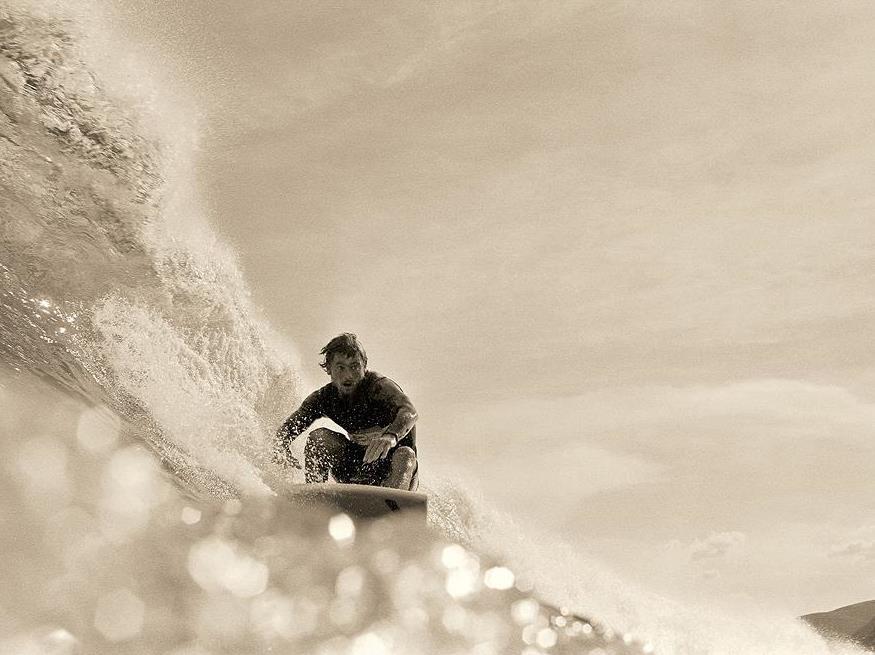John Witzig, Ted at Bells Beach (1971)
‘Often on the way to Angourie we’d just pull in to some isolated beach headland, light a fire and sleep on the ground at night with the stars over our heads and the only sound was the ocean and our laughter. For us, it was pure bliss. To wake up next morning with a clean swell and no one anywhere was as good as life could get and in our innocence we were probably then about as rich as you could ever want to be.’ -Albert Falzon
In Ancient Greek mythology, the term Arcadia connoted a pastoral idyll, unadulterated by human civilisation and inhabited by pipers, satyrs, nymphs, bards, shepherds and sheep. This was the original ‘alternative lifestyle’, whereby language and custom would remain untouched by the vagaries of the mainstream. In Australian art, the most prominent depictions of Arcadia are those of Goulburn-born landscape painter Sydney Long, informed by the Art Nouveau and Symbolist movements of the belle époque. In works such as By Tranquil Waters (1894) and Pan (1898), the Australian bush is imbued with Arcadian qualities: spontaneity, musicality and oneness with nature.
But as this exhibition concedes, there is a bittersweet quality to the Arcadian vision. Arcadia denotes an escape from convention that is ultimately unattainable, and because of this, the term is tinged with melancholy. Older viewers may feel a pang of nostalgia when entering this exhibition. While there’s no doubt that a large core of committed surfers remains, the broader sub-culture has faded. Nowadays, the notion of city-dwellers attempting to be ‘at one with nature’ by piling into a kombi van and smoking copious amounts of cannabis seems slightly pathetic, even if it was crazy cool at the time.
Arcadia: Sounds of the Sea, currently on show at the National Portrait Gallery, features 40 photographic portraits by John Witzig alongside the large-scale ink drawings of contemporary artist Nicholas Harding and ‘psychedelic film footage’ from Albert Falzon’s Morning of the Earth (1971). The three artists have in common their attraction to the same strip of Northern NSW coast, albeit at different times. For Witzig and Falzon, it was during the 1970s as surfers, photographers and co-founders of surfing magazine Tracks; for Harding, it was as a British-born contemporary artist a decade or so later.
During the late 1960s and early 1970s, surfing came to represent an all-encompassing lifestyle, rather than a mere pastime. The surfer became an ideal of unencumbered masculinity, as is keenly demonstrated by Falzon’s portrait of Nat Young (c. 1968). Framed by a wreath of bleached corkscrew curls and wiry stubble, Young’s eyes – while not meeting ours – harbour a slow-burning intensity suggestive of his courage in the surf. Witzig’s Country Soul (1969) and the opening shots of Morning of the Earth attest to the wholesomeness of the surfing lifestyle, whereby people lived simply in corrugated iron lean-tos and bartered home-grown produce. Funnily enough, the rustic imagery and crisp tonality of Country Soul bring to mind the still-lives of the Dutch Old Masters: a tousle-haired couple and their baby sit at a table laden with organic fruit and veg.
Harding’s drawings are perhaps a surprising inclusion to this show, since none of them is a true portrait. His compositions are dominated by Pandanus palms and other dense coastal vegetation, often at the expense of human subjects. They are far from boring, however, as Harding’s distinctive technique of ‘skinning’ paper to expose its rough, pulpy under layer serves to intensify the morass of leaves and roots extending across the picture plane. Like the recent charcoal drawings of David Hockney, the tonal subtleties in Harding’s works are such that colour almost becomes implicit.
The curatorial style of this exhibition is deliberately loose and understated. As curator Sarah Engledow explains, ‘Arcadia is anti-didactic for anything else would be contrary to the spirit of its content.’ In some ways the very idea of a publicly funded institution attempting to piece together an exhibition about the surfing sub-culture of the 1970s – which was necessarily impulsive, and anti-establishment – seems a contradiction in terms. The irony of viewing this exhibition in Canberra, that inland capital of all that is uncool, was also not lost on me, but that’s another thing altogether.
Rating: 4 out of 5 stars
Arcadia: Sounds of the Sea
John Witzig, Nicholas Harding and Albert Falzon
National Portrait Gallery, King Edward Terrace, Parkes, ACT
www.portrait.gov.au
14 August – 19 October





